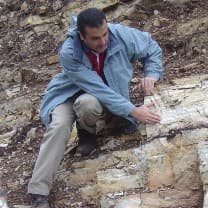Evolution of Crustal-Scale Shear-Zones
A special issue of Geosciences (ISSN 2076-3263). This special issue belongs to the section "Structural Geology and Tectonics".
Deadline for manuscript submissions: closed (15 May 2021) | Viewed by 590
Special Issue Editors
Interests: field geology; tectonics; geological mapping; structural geology; exploration geophysics; geodynamics
Special Issues, Collections and Topics in MDPI journals
Interests: metamorphic petrology; metamorphic geology; structural geology; field geology; geomatics
Special Issue Information
Dear Colleagues,
It is our pleasure to announce that we have agreed to assemble a Special Issue focussing on the evolution of crustal-scale shear zones (CSSZs). CSSZs often exhibit a complex variety of fault-rocks and related structures that record changes in deformation mechanisms during progressive deformation, and/or deformation during exhumation. CSSZs and the structures associated with them play a crucial role in the development of orogenic belts.
Activity along CSSZs may persist over considerable periods of time and exert significant influence over geodynamic evolution. From the nucleation of CSSZs, within deep-seated crustal systems commonly rooted in the middle to lower crust, up to surficial thin-skinned activity, they are characterised by a range of kinematics and influenced by different rheological behaviours, which, potentially, reflect plate boundary kinematics.
Generally, former deep-seated shear zones, often characterised by crystal–plastic microstructures, are overprinted during exhumation by a switch to a brittle fracturing behaviour. Recent innovative techniques permit quantitative analysis of ancient mylonitic strain-rates, which are largely accommodated by crystal–plastic deformation. In addition, quantitative field investigations, which are integrated with GPS, together with persistent-scatter methods, are useful to bracket the present-day motion of active CSSZs that bound crustal blocks in collisional settings.
In this Special Issue, we would like to encourage the submission of scientific papers focussing on the study of plastic- and/or brittle-related crustal-scale shear-zones, with particular reference to those characterised by a transition from plastic- to frictional-deformation behaviour. Multiscale structural investigation, supported by the analysis of physical conditions during deformation, represents a fundamental tool to unravel the geodynamic evolution of many ancient and currently active plate boundaries where significant amounts of deformation have accumulated.
Prof. Dr. Carmelo Monaco
Dr. Gaetano Ortolano
Prof. Dr. Ian Alsop
Guest Editors
Manuscript Submission Information
Manuscripts should be submitted online at www.mdpi.com by registering and logging in to this website. Once you are registered, click here to go to the submission form. Manuscripts can be submitted until the deadline. All submissions that pass pre-check are peer-reviewed. Accepted papers will be published continuously in the journal (as soon as accepted) and will be listed together on the special issue website. Research articles, review articles as well as short communications are invited. For planned papers, a title and short abstract (about 100 words) can be sent to the Editorial Office for announcement on this website.
Submitted manuscripts should not have been published previously, nor be under consideration for publication elsewhere (except conference proceedings papers). All manuscripts are thoroughly refereed through a single-blind peer-review process. A guide for authors and other relevant information for submission of manuscripts is available on the Instructions for Authors page. Geosciences is an international peer-reviewed open access monthly journal published by MDPI.
Please visit the Instructions for Authors page before submitting a manuscript. The Article Processing Charge (APC) for publication in this open access journal is 1800 CHF (Swiss Francs). Submitted papers should be well formatted and use good English. Authors may use MDPI's English editing service prior to publication or during author revisions.
Keywords
- Field mapping of tectonic structures
- Quantitative structural analysis
- Strain-rate analysis
- Diffusional time-scale
- Rheological behaviour
- Kinematic indicators
- Active shear zones
- Active deformation monitoring







